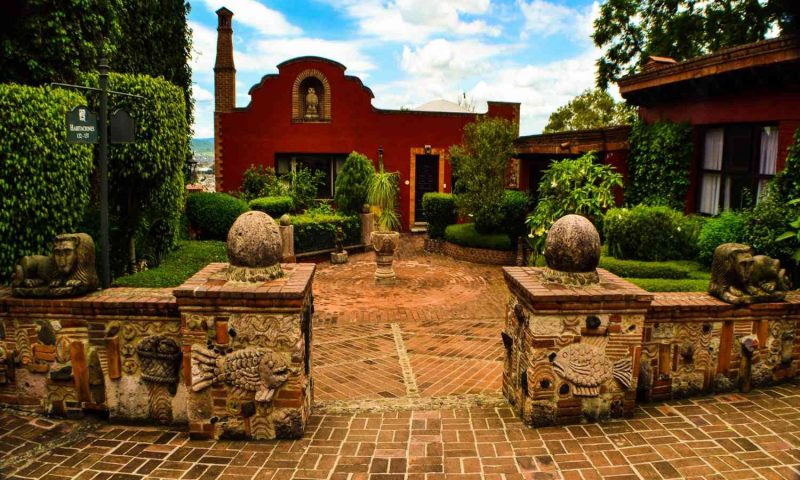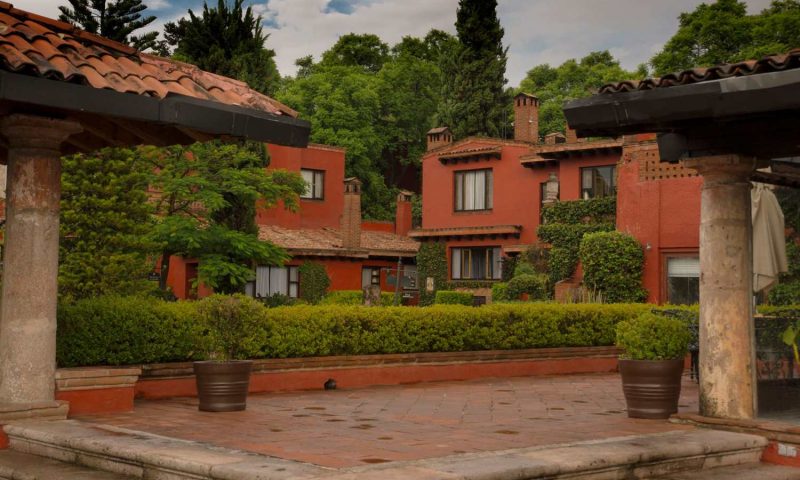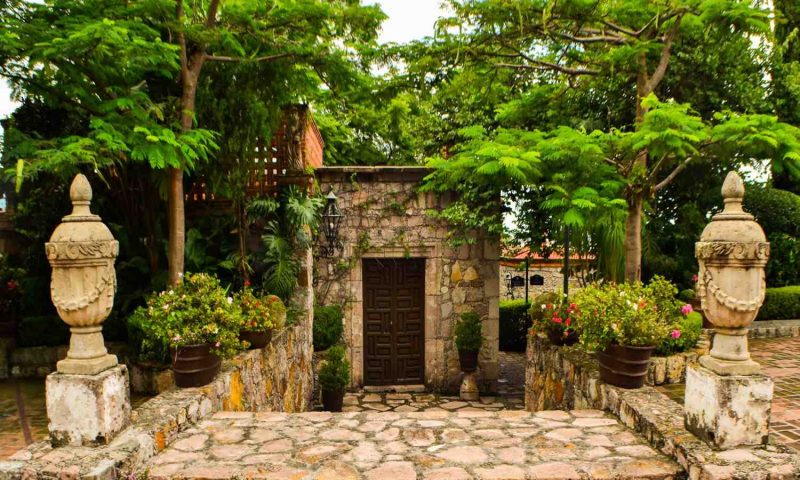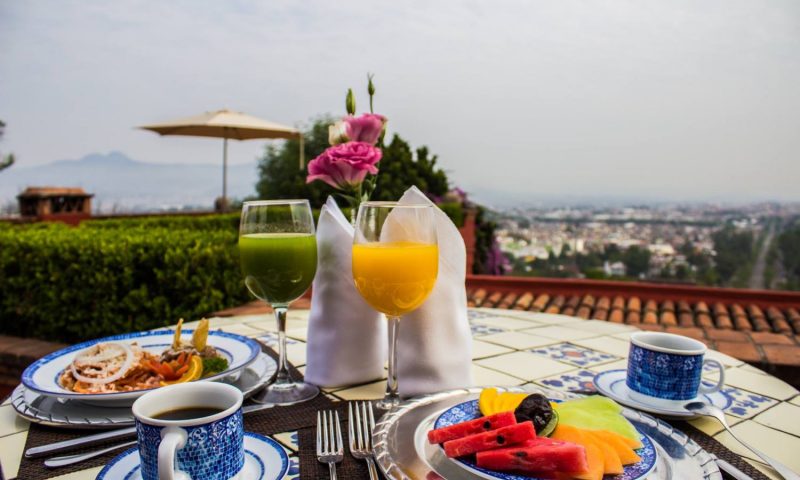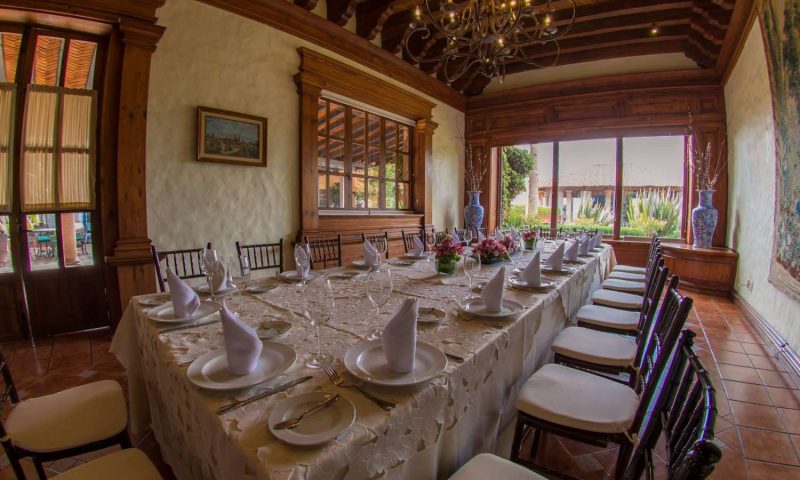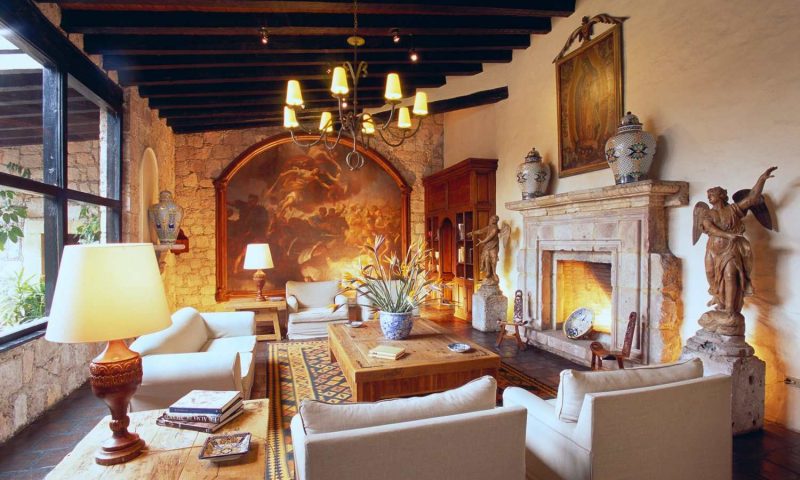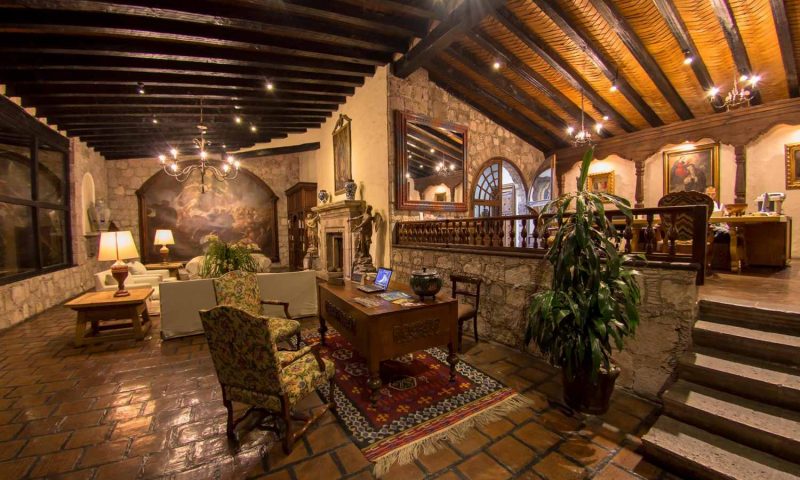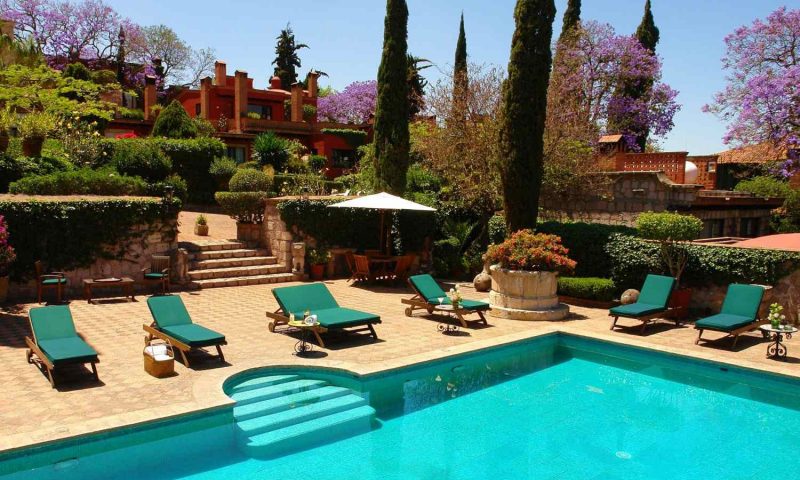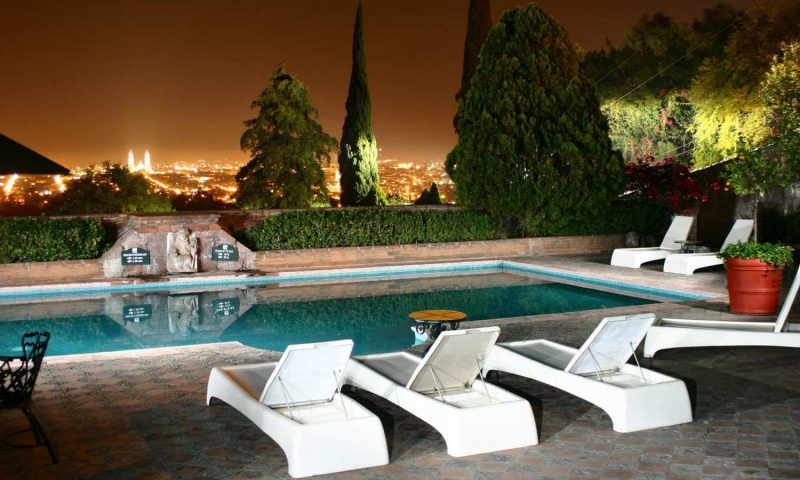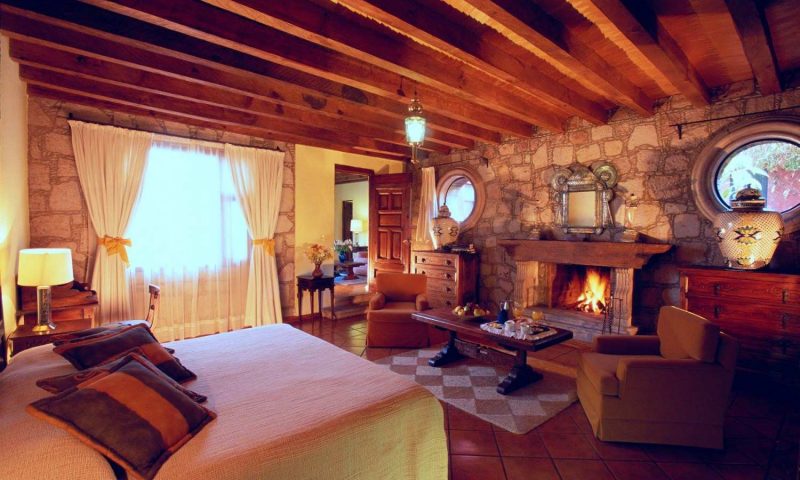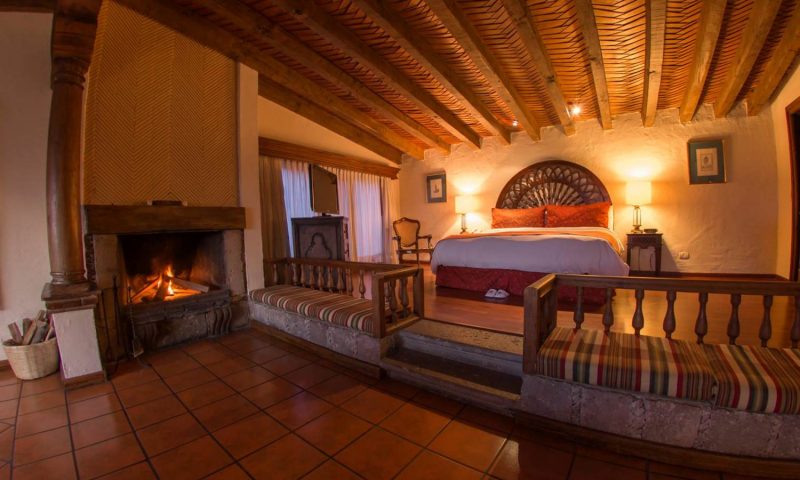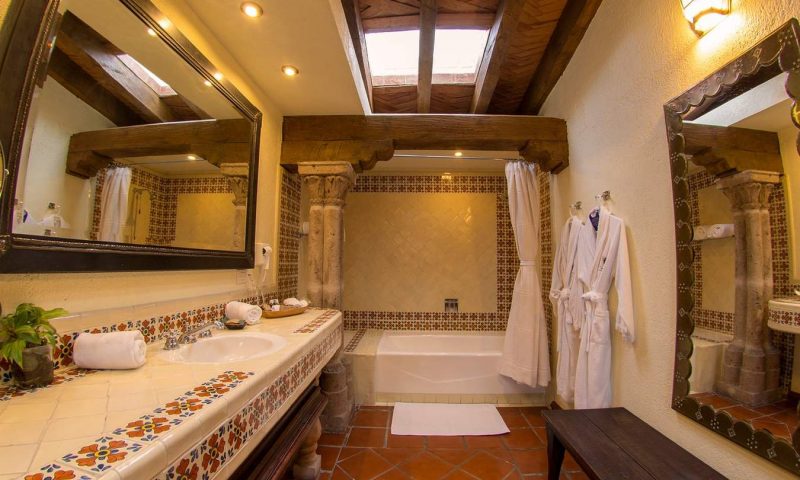Villa Montaña Hotel & Spa is decorated with artworks from various places during the time of the viceroyalty and selected handicrafts. Its suites and rooms are nestled among patios and gardens decorated with sculptures of the region and in the middle of exotic plants, some of which are unique.
For example, the elephant’s foot or ponytail palm (Beaucarnea recurvata), which is 475 years old, originally from the state of Guerrero, and weighed three tons when it was acquired 25 years ago; giant birds of paradise (Strelitzia nicolai) with white flowers; beautiful staghorn ferns (Platycerium bifurcatum); different varieties of cactuses; Japanese sago palms (Cycas revoluta); and many varieties of orchids that bloom in different times of the year make our gardens pleasant to walk through.
Michoacán has more than 300 types of orchids that you can observe and purchase at the botanical garden in the city. From the terrace and from the heated swimming pool, you can see the majestic, baroque cathedral in pink stones, as well as numerous monuments built since the 16th century.
Both the shrine of the Virgin of Guadalupe, also called the temple of San Diego, with its typical baroque and rococo décor, and the magnificent Aqueduct, built in 1708, are worth a visit. They are just a short distance from the historical center.
History
In 1949 a North American by the name of Raymundo Coté, due to the condition of his health, decided to move to Mexico. For various reasons he was delayed in his journey in the city of Morelia because of a problem with his vehicle. There he discovered in the hill of Santa Maria de Guido an ideal place to live.
His wife had various hotels in the state of Virginia, in the U.S. So he decided to build his own in Morelia. He bought two large houses and vacant land to construct it. In 1955 he began operations in Villa Montaña with 73 rooms.
He himself was in charge of administering the hotel, attending to invited guests, and cooking international dishes served in a buffet. He expanded the number of recipes until finally he edited a book about the kitchen of Villa Montaña.
With the passing of time, he decided to sell the hotel and retire in Cuernavaca. In 1973 he sold the hotel to Count Philippe de Reiset, a French citizen who was seduced by the beauty of Mexico. A great art connoisseur and restorer of building, museums, and statues, Reiset left his unique mark on Villa Montaña.
With the passing of time the suites were redesigned, giving rise to the hotel’s refined and elegant atmosphere. Among the most notable changes were the relocation of the pool and the construction of a tennis court as well as the event room.
To adapt to the needs of our guests, we created and elegant event room and constructed a state- of-the-art kitchen and a spa with all the amenities and highly professional service.
The inspiration behind the detailed décor of the rooms and the exquisite cuisine in the restaurant is also reflected in the gardens, known for their exotic plants and flowers that add to the unique ambience at Villa Montaña.
Every suite and room is original in its dimension and décor, making for a unique experience. To conserve the authenticity of the viceroyalty of Morelia, Count Reiset together with his wife traveled around Mexico looking for unique pieces of art with which to decorate Villa Montaña.
Today the hotel has 36 suites and rooms constructed among patios and gardens, many of them with a view of the historical center through windows and from terraces.
Currently the hotel has all of the modern amenities and services. The view of Morelia and the cathedral is spectacular both during the day and at night, as the hotel is only 15 minutes from the historical center.
Restaurant & Bar
Savor fine regional and international cuisine and test your senses with exquisite dishes, whose ingredients have been carefully selected by the chef to satisfy the most discriminating palates. You will have a gourmet experience that surely you will want to repeat.
Our restaurant, which is internationally recognized, offers a variety of dishes featuring exquisite Mexican and international cuisine. The desserts are well-known. Our bar had a great panoramic view of Morelia, and it offers a variety of cocktails as well as national and imported drinks.
In an atmosphere of casual elegance, guests enjoy the flavors of appetizing national and international cuisine, enhanced by locally-produced condiments and edibles. Dishes and drinks can be savored in the terrace of the restaurant-bar while admiring the spectacular view of Morelia.
The restaurant of Villa Montaña Hotel & Spa is known for its Sunday brunch that features dishes from Michoacán. Guests delight in the savor of freshly-made tortillas, uchepos, corundas, typical dishes, traditional menudo and quesadillas made-to-order.
Our renowned chef, Armando Bernal Chávez, who oversees the buffet every Sunday, asserts that preparing brunch at Villa Montaña “is like preparing the dishes for parties and traditional events that remind you of your grandparents. It is a ritual that includes typical flavors of Michoacán and delights our guests every Sunday.”
Intimate gatherings with the best morning views of the historical center of the city. Light and live music to enjoy an exception Sunday. We hope you can join us one Sunday, after 9:30 am o’clock to 1:30 pm o’clock, in this gathering of friends and family.
Events
Allow our team of professional help you celebrate an unforgettable event in an enchanted, exclusive place. We offer you a variety of menus designed for the most sophisticated palates, in outdoor settings and in elegant halls. Events are specially tailored to meet your needs, from 2 people to 450 invited guests, with a spectacular view of the cathedral.
SPA Villa Montaña
Enjoy the best and most exclusive spa in the city, one that is founded in the 7 pillars of wellbeing and the principles of hydration, oxygenation, and regeneration of the skin.
The spa integrates techniques from different parts of the world to offer a selection of treatment based on a superb combination of natural ingredients that revitalize your body and mind. You will be attended to by highly professional therapists who can design treatments especially for you.
The Cathedral of Morelia
The Cathedral of Morelia is an emblematic building of the city and in the same way it is an icon for the entire state of Michoacán. Its construction stands out for the height of its two towers, which can be seen throughout the Morelia Valley.
The Cathedral of Morelia is cataloged as one of the most beautiful cathedrals in all of Mexico and its majestic construction has become one of the favorite places for residents and visitors. Its baroque-style pink quarry walls and boards are attractive to national and international tourism.
Inside the Cathedral of Morelia, ornamentation predominates as the basis of its decoration; at the same time it is perfectly adorned with neoclassical altarpieces. The history of the Cathedral of Morelia is rich in anecdotes and facts.
When the bishopric of Michoacán was founded in 1536, the towns of Tzinzuntzan, later Pátzcuaro and finally the City of Valladolid were held as seats; Later, its construction began in the year 1600 and ended in 1744. Almost 150 years of history alone of construction speak for themselves with the beauty that has been reflected during all these years of tradition.
Inside the Cathedral, various treasures are displayed that account for the traditions of our region. Among the historical beauties that the Cathedral protects, we find the Baroque-style silver Manifestor from the 18th century; the silver Baptismal Font, in neoclassical style, also from the 18th century; the Monumental Organ, from the beginning of the 20th century, consisting of 4,600 flutes or voices.
On the other hand, it is worth highlighting the image of the Lord of the Sacristy, made with the pre-Hispanic technique of corn cane paste, from the 16th century, as well as valuable paintings located in the sacristy and the chapter house.
In addition to its ecclesiastical tradition, the Cathedral of Morelia has a wide cultural tradition, in the months of May the Morelia International Organ Festival is held as part of the celebrations for the anniversary of the City.
Its cultural presentations extend with the participation of the Michoacán State Symphony Orchestra. The Cathedral houses and spreads tradition, music and culture. It is a venue for different voices that has become a fundamental part of the City.
The Towers of the Cathedral have become an emblem. Each one has three bodies; its height is between 66 and 70 meters high. Both towers serve as a lookout for the Cathedral, giving an imposing and architecturally balanced appearance. One of the towers has an iron cross that symbolizes nature; while the other Tower has a stone cross that represents the human nature of Jesus.
The Cathedral of Morelia has scenic lighting of singular beauty placed by the company that illuminated the Eiffel Tower in Paris. On Saturdays at 8:45 p.m., the Cathedral offers a light, sound and fireworks show with this illumination. The Lighting of the Cathedral is an activity liked by visitors and residents.
The beautiful Cathedral of Morelia covers two blocks from the city center. This cathedral is often referred to as the most beautiful in all of Mexico and is also the only one in the country facing east, rather than facing north like all cathedrals in the country.
During the Day of the Dead celebration, the lighting, atmosphere and modern traditions, Christian and pre-Hispanic traditions converge into one; the beauty of these Day of the Dead rites, and the majesty of this site attract all kinds of visitors at any time of the year.
The historic Aqueduct of Morelia
The current work of the Morelia Aqueduct is built with quarry, which is consistent with the rest of the buildings in the Historic Center of the city of Morelia. Morelia’s first aqueduct was built in 1549 with a wooden structure, shingles, and trunks carved like canoes that carried water.
Later, at the end of the 16th century, its structure was replaced by one made of lime and stone that lasted until the beginning of the 18th century, when it began to be replaced by a quarry by order of the sixteenth bishop of Michoacán, Manuel de Escalante Colombres y Mendoza.
The Morelia aqueduct is in the Valladolid style; In 1997 it underwent a comprehensive restoration, and later the stage lighting that characterizes it today was placed. In the past, this aqueduct was in charge of carrying and supplying water to the edge of the city. Later it would distribute it by underground pipe.
The Aqueduct has two water tanks located about 700 meters apart. Other characteristics are its baroque style, its maximum height of more than 9 meters and its 253 arches. The total of this construction reaches more than 1700 meters
It is considered one of the most beautiful and best preserved in Mexico. In terms of engineering and at an urban level, it is the most important construction in the City; It has the largest original structure of those that remain in Mexico; It was a determining element for the Historic Center of Morelia to be declared a World Heritage Site by UNESCO in 1991.
Currently, this is one of the most visited places, it is a constant postcard that can be seen on the social networks of international national tourists; this has made it an emblem of the City.
Pátzcuaro Michoacán Pueblo Mágico
The magical town of Pátzcuaro is one of the most picturesque and emblematic places in Michoacán and the whole country. Its mystical atmosphere attacks millions of visitors who, fascinated by it all, recommend and return to this place, one of the most beautiful, mythical, and marvelous corners of Mexico.
The shores of the lake are home to Purépecha ceremony, a culture that has been preserved in spite of historical changes. The language, gastronomy, handicrafts, and people all make up a unique setting.
Pátzcuaro is a peaceful, magical, calm community; in addition, it is of the most enchanting places in all of Mexico. Without doubt it is worthwhile to take stroll in the center of Pátzcuaro, either in the Vasco de Quiroga Square or the Big Square. Close by is the Gertrudis Bocanegra Square.
In this place, besides its famous market, one finds the ex-convent of St. Augustine, founded in 1576 and the served as a convent for the Augustinians. On display inside the convent is a spectacular mural painted Juan O’Gorman that depicts an interesting summary of the history of the Purépecha people.
In Pátzcuaro the cuisine delights your taste buds, since you have the chance to savor traditional corundas and uchepos. In the markets and local restaurants you can enjoy dishes that provide an unforgettable dining experience.
In the streets you discover arts and crafts made by Michoacán hands that create colonial furniture made of rustic wood with an antique finishing. You also find baskets weaved out of chuspata, a plant that grows on the shores of the lake, as well as very fine works of lac, a varnishing technique that was developed in the colonial period, as well as textiles that are a century-old Purépecha heritage.
Along Navarrete Street, you come upon the temple and hospital of St. John of God, built in the middle 17th century. From there it is a short distance to the Temple and Square of St. Francis, where every weekend there is an open-air market of clay tiles, handiworks of wood, and woven baskets. The entrance to the cloister is in plateresque style, and inside you can admire an image of Our Lord of the Third Order, made with cornstalk paste.
Further ahead you come across the Hospitalito (small hospital), the oldest church in Pátzcuaro, founded by the Franciscans in the 16th century and featuring a Renaissance style entrance.
In the next block you discover the Sanctuary of Guadalupe, a neoclassical church from the beginning of the 19th century that still holds some original sculptures that represent four of the seven theological virtues: charity, temperance, fortitude, and faith.
Surely you have heard of the magnificent and magical experience that people enjoy each year on the Day of the Dead in Pátzcuaro. The landscape, people, countryside and everything else is prepared to receive the souls of the dead that return home, to the place where altars of foods await them, to the site adorned and scented by flowers, where candles burn that illuminate the dark road that separate the underworld from the land of the living.
In addition to celebrations remembering the dead in the cemeteries of the towns surrounding the lake and on the islands, along the esplanade of the Vasco de Quiroga Square you can take in an exceptional display of arts and crafts from all corners and ethnicities of Michoacán.
Here you find fine pieces of pottery, jewelry, textiles, string instruments, and carpentry, among other types of popular handicrafts. Also, during the night there is a traditional organ concert in the Basilica of Nuestra Señora de la Salud (Our Lady of Health).
The celebration of the dead is an event at which thousands of visitors gather in the cemetery located at a natural terrace in front of the great body of water. Despite the large number of people who congregate on the island on this day, this place is recommended for the itinerary of those who want to know one of the oldest expressions of this celebration in Michoacán.
Without a doubt, visiting Pátzcuaro is a must at any time of the year. It is charming and magical, and steeped in history in every street and sight of interest.
Santa Clara del Cobre Michoacán
Santa Clara del Cobre is one of those Pueblos Mágicos (magical towns) that stands out for its beauty, charm and welcoming warmth. The residents of Santa Clara del Cobre preserve traditions that originated in the pre-Hispanic times, and the majority of the population is made up of artisans who preserve techniques that have been modified and adapted with the passing of time.
Today Santa Clara del Cobre offers a range of products made by goldsmiths to its visitors, and it has achieved both national and international recognition for its beauty and the goods it offers.
In Santa Clara del Cobre, tourists are amazed by the craftwork, from the pots, fruit bowls, jewelry and candelabras, to the finely detailed furniture. This beautiful little town is a must-visit among the towns of Pátzcuaro and Valladolid. In 1563 it received the name Santa Clara together with the name Cobre (copper), given for the specialized work of the residents.
Here you can walk through the streets and discover and endless number of handicrafts and visit the Capilla Hospital, a historic building in baroque style locate in the main square. You can also visit the community church, a place of great beauty dating from the 19th century.
Of course, you can take in the scenery from the local kiosk that, it is worth mentioning, was made by artisans of Santa Clara and is located in the main square. In addition, you can visit the Museo Nacional del Cobre (National Museum of Copper), which holds several handicrafts created by those who work in this Michoacán town.
Nature dominates the scenery of Santa Clara de Cobre. The Lake of Zirahuén, a well-visited area located just 12 kilometers from Santa Clara, is a place where you can enjoy boat excursions and activities related to ecotourism.
The cuisine of this region features various tasty specialties, for example, marinated lamb, mutton, and various maize dishes are the favorites of both visitors and the locals. Santa Clara del Cobre is located close to Pátzcuaro, which helps plan an ideal itinerary for getting to know two of the loveliest places in Mexico.
Santa Clara del Cobre offers a wide range of tourist sites, among other sites, but there is one place that is a must-see: the Escuela Nacional de Artesano y el Taller el Portón (National School of Artisans and Workshop).
The first is a place where one learns different techniques to make copper products, whereas the workshop is where in addition to working with copper one learns how to make fine silver products.
In 2010, Santa Clara del Cobre was declared a magical town, and this news elevated Michoacán pride in Mexico and the world. If there is something that has brought fame to Santa Clara, it is the thriving copper industry of this magical place.
Since the pre-Hispanic times, this community has been characterized by the genuine production of unique pieces made of copper. The skills of the artisans of this town are known and valued today worldwide. This is a recognition that Santa Clara del Cobre has gained for itself for hundreds of years.
There is another place that is a must-see for visitors—the Templo de Nuestra Señora del Sagrario (Our Lady of the Sagrario), dedicated to St. Clare of Assisi. The inside of the church is adorned with beautiful candelabras of copper and cornfields made of the same metal used in the front pillars.
Crossing the Street one finds the Templo de la Inmaculada Concepción (Immaculate Conception Church), built in the 17th century. Next to the church, the Huatápera is preserved as the oldest chapel in the town, inside of which you can admire two images made of cornstalk paste that represent St. Clare and St. Francis.
You might think that there are copper mines in the areas nearby Santa Clara, and certainly they existed at one time. But they have been depleted, and that is why nowadays materials such as cables, electronic circuits, and plumbing pipes are recycled.
To do this work, there are various foundries that carry out the processes of treating, purifying, and melting the material that will be used by the artisans. Santa Clara del Cobre is a magical town that lives up to its name, a place filled with magic and tradition that you must get to know and enjoy in your next trip.
